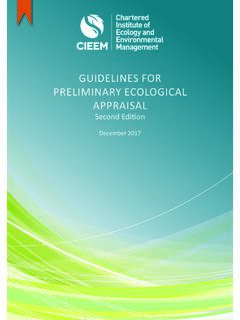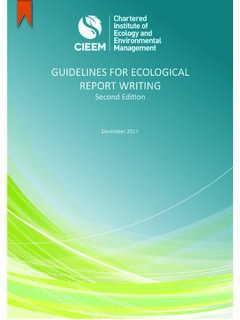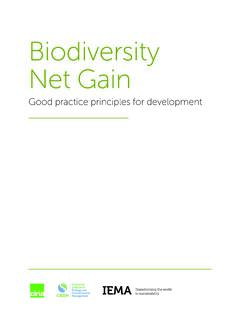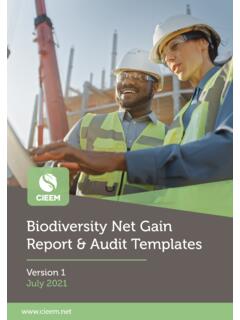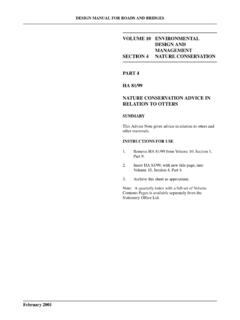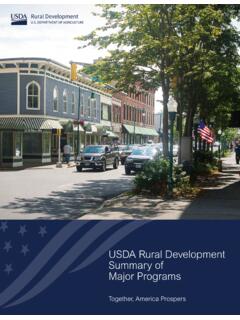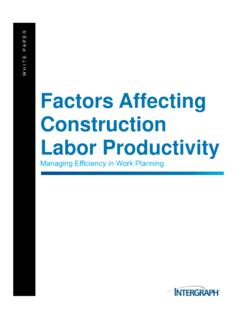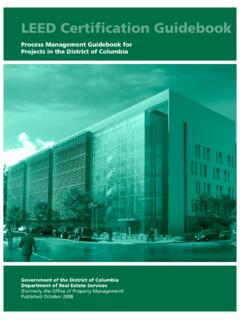Transcription of ON THE LIFESPAN OF ECOLOGICAL REPORTS & SURVEYS
1 ON THE LIFESPAN OF ECOLOGICAL REPORTS & SURVEYSIt is important that planning decisions are based on up-to-date ECOLOGICAL REPORTS and survey data. However, it is difficult to set a specific timeframe over which REPORTS or survey data should be considered valid, as this will vary in different circumstances. In some cases there will be specific guidance on this (such as for the age of data which may be used to support an EPS licence application). In circumstances where such advice does not already exist, CIEEM provides the general advice set out some projects the time taken between commencing the scoping or design and submitting a planning application can be several years, and this can result in the early ecology SURVEYS becoming out-of-date (based on the advice set out below); this can lead to additional costs for developers associated with updating survey data.
2 Nevertheless, there are considerable advantages associated with undertaking SURVEYS early during the scoping or design phases of a project . ECOLOGICAL consultants should give careful consideration to which, if any, SURVEYS need to be updated; design their data collection in a way which maximises the benefits of early SURVEYS whilst minimising the costs to developers; and provide clarity on the likely LIFESPAN of SURVEYS in their OF DATAREPORT / SURVEY VALIDITYLess than 12 monthsLikely to be valid in most monthsLikely to be valid in most cases with the following exceptions: Where a site may offer existing or new features which could be utilised by a mobile species within a short timeframe (see scenario 1 example); Where a mobile species is present on site or in the wider area, and can create new features of relevance to the assessment (see scenario 2 example).
3 Where country-specific or species-specific guidance dictates authors should highlight where they consider it likely to be necessary to update SURVEYS within a timeframe of less than 18 months to 3 yearsA professional ecologist will need to undertake a site visit and may also need to update desk study information (effectively updating the Preliminary ECOLOGICAL Appraisal) and then review the validity of the report, based on the factors listed below. Some or all of the other ECOLOGICAL SURVEYS may need to be updated. The professional ecologist will need to issue a clear statement, with appropriate justification, on: The validity of the report; Which, if any, of the SURVEYS need to be updated; and The appropriate scope, timing and methods for the update survey(s).
4 The likelihood of SURVEYS needing to be updated increases with time, and is greater for mobile species or in circumstances where the habitat or its management has changed significantly since the SURVEYS were undertaken. Factors to be considered include (but are not limited to): Whether the site supports, or may support, a mobile species which could have moved on to site, or changed its distribution within a site (see scenario 1&2 examples); Whether there have been significant changes to the habitats present (and/or the ECOLOGICAL conditions/functions/ecosystem functioning upon which they are dependent) since the SURVEYS were undertaken, including through changes to site management (see scenario 3 example).
5 Whether the local distribution of a species in the wider area around a site has changed (or knowledge of it increased), increasing the likelihood of its presence (see scenario 4 example).The report is unlikely to still be valid and most, if not all, of the SURVEYS are likely to need to be updated (subject to an assessment by a professional ecologist, as described above).More than 3 yearsADVICE NOTE APRIL 2019 1 Trees or buildings on site have been surveyed for evidence of bat roosts and none were found; new roosts may be present, and trees or buildings may have developed new features which were not previously present.
6 An update bat roost survey is likely to be required. One or more potential otter resting sites have been identified, although there was no evidence of use at the time of the survey; such features may have been used by otters during the intervening period. An update otter survey is likely to be required. 2 A badger survey confirmed the presence of badgers on site; new setts may have been excavated within the site. An update badger survey is likely to be An area of grassland was heavily grazed by cattle at the time of the original survey and was considered to be unsuitable for reptiles, although slow-worms were known to be present in the wider area; grazing has since ceased and the grassland has been cut once annually, which has encouraged the development of a tussocky sward which provides suitable habitat for slow-worms.
7 A reptile survey is now likely to be A water vole survey confirmed their absence from the site but identified them as present in the wider area surrounding it; a recovery project is underway in the local area through a mink control programme, which is encouraging the spread of water SCENARIOS43 Southgate Street Winchester, Hampshire SO23 9EH t: 01962 868626 e.


